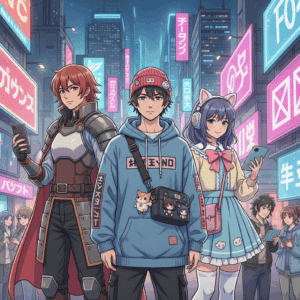Overview of live-action adaptations
Live-action anime adaptations have experienced remarkable growth in the audiovisual industry, driven by the global popularity of anime. This format seeks to attract new audiences through real actors, offering a fresh perspective on iconic stories.
Japan and Hollywood are leading this trend, albeit with different approaches and results. The rise of these productions demonstrates a growing interest in adapting animated narratives to formats more accessible to a general audience, while maintaining their original essence.
Growth and motivations in the audiovisual industry
The increase in live-action adaptations is due to the global success of anime, which has sparked the interest of studios and streaming platforms. They are looking to diversify their content to attract both longtime fans and new viewers interested in live-action adaptations.
Furthermore, technological advancements allow for the recreation of complex visual effects and environments faithful to the original material, offering greater opportunities to attract audiences. This motivates the industry to invest in projects with high commercial and cultural potential.
Differences between Japanese and Hollywood productions
Japanese productions typically focus on fidelity to the original material, paying close attention to details in the manga and anime, and preserving the cultural essence. They often maintain a closer approach to the narrative and aesthetics characteristic of the genre.
On the other hand, Hollywood tends to adapt stories for a broader Western audience, sometimes altering narrative or visual aspects. This can generate criticism for a lack of fidelity, although it also opens the door to reinterpretations and high-production effects.
Featured projects and upcoming releases
The most anticipated live-action projects capture a great deal of international attention, standing out for their impact on both fans and new audiences. These productions balance faithfulness to the manga with innovative adaptations.
The industry is betting on iconic titles, ensuring quality and the involvement of the original creators. This generates high expectations about how these adaptations will visually and thematically represent the works.
Upcoming releases promise to broaden the format's reach, with diverse genres including adventure, horror, and science fiction, solidifying the popularity of live-action in the global market.
One Piece live-action series and its faithfulness to the manga
The One Piece live-action series stands out for its faithful representation of the manga, with the active supervision of Eiichiro Oda, which guarantees a careful and respectful adaptation.
Planned for 2026, it will include iconic arcs such as Drum Island and Loguetown, with essential characters like Tony Tony Chopper and villains from Baroque Works, intensifying fan interest.
This version promises to maintain the unique adventurous and visual spirit, thanks to a diverse cast and effects that seek to capture the essence of the original work in every scene.
Mieruko-chan movie and the mix of horror and comedy
Mieruko-chan, released in 2025, successfully combines elements of horror and comedy, maintaining the characteristic atmosphere of the original manga in a captivating cinematic format.
Starring Nanoka Hara, the story follows the young woman's ability to see spirits and her struggle to ignore them, creating a balance between scary moments and light humor.
This film has been received with interest by audiences who enjoy hybrid genres, highlighting Japanese creativity in adapting works with unconventional themes.
Hollywood productions like The Promised Neverland
Hollywood continues to explore adaptations with The Promised Neverland, a project backed by Amazon Studios that appeals to anime fans with a renewed visual and narrative approach.
Produced by talents from the Spider-Man: Into the Spider-Verse universe, it seeks to maintain the tension and mystery of the original manga for a demanding Western audience.
This commitment reflects Hollywood's intention to bring Japanese stories to global audiences, while preserving the quality and personality that distinguishes them.
Other titles in development with high interest
The demand for live-action adaptations drives projects like Sword Art Online, Mobile Suit Gundam Wings, and Steins;Gate, all with a strong fan base and high levels of expectation.
Many seek to maintain their original Japanese cast to preserve authenticity, while others explore new interpretations that can expand the original universe and its reception.
These titles demonstrate the thematic and genre diversity under development, showing a promising future and sustained interest in the global audiovisual industry.
Successes and challenges in live-action adaptations
Live-action adaptations have achieved significant milestones, combining quality and faithfulness that have won over both critics and fans. However, the process is not without its challenges, which test producers and directors.
The balance between respecting the original material and offering an engaging cinematic experience is key. This challenge makes all the difference between a celebrated success and a project that generates rejection or skepticism.
Examples of successful and well-received adaptations
Films like Rurouni Kenshin have been acclaimed for their technical quality and respect for the manga, earning a prominent place in Japanese and international pop culture.
Series like Yu Yu Hakusho on Netflix demonstrate that the format can work when there is careful direction and the essence of the original work is valued.
These cases show that, when there is commitment to the story and its characters, live-action adaptations are able to attract both old fans and new audiences.
Failures and public skepticism
Failed adaptations like Dragonball Evolution fueled public distrust, mainly due to major deviations in narrative and characters.
The rejection arises when fans perceive that the project does not respect the spirit or key characteristics of the anime, negatively affecting reception and box office.
This skepticism forces producers to seriously consider fidelity and quality to avoid repeating mistakes and ensure the acceptance of their works.
Trends and future expectations
Live-action adaptations have solidified their place in the industry, showing a significant improvement in cinematic quality and fidelity to the original stories.
Audiences demand productions that combine outstanding visual effects with narratives that respect the essence of anime, which drives more rigorous and careful projects.
Consolidation of the trend and cinematic quality
In recent years, the technical and artistic quality of live-action adaptations has risen, with improvements in special effects, direction, and production, bringing them closer to the anime experience.
These improvements solidify the trend as a valid way to expand the universe of animated stories, allowing studios to experiment without losing the original essence.
Investment in production and the active participation of original creators contribute to adaptations being more highly valued, overcoming the initial skepticism of the public.
Importance of respecting the original material
Respect for the original plot, characters, and atmosphere is key to success and acceptance among fans, who tend to be very critical of excessive changes or alterations.
Maintaining the essence of anime is essential to creating an emotional connection with the audience, which translates into better reviews, greater loyalty, and a positive cultural impact.
Adaptations that prioritize this fidelity manage to attract both manga fans and new audiences, balancing innovation with narrative tradition.






